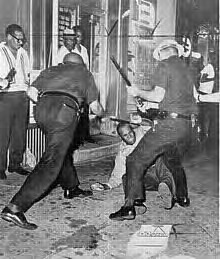"A ghetto is an area where people from a specific racial or ethnic background are united in a given culture or religion live as a group, voluntarily or involuntarily, in milder or stricter seclusion. The word historically referred specifically to the Venetian Ghetto in Venice, Italy, where Jews were required to live. It was later applied to neighborhoods in other cities where Jews were required to live. The corresponding German term was Judengasse; in Moroccan Arabic ghettos were called mellah. The term came into popular, world-wide use during World War 2, in reference to Nazi ghettos. The term now commonly labels any poverty-stricken urban area."
are united in a given culture or religion live as a group, voluntarily or involuntarily, in milder or stricter seclusion. The word historically referred specifically to the Venetian Ghetto in Venice, Italy, where Jews were required to live. It was later applied to neighborhoods in other cities where Jews were required to live. The corresponding German term was Judengasse; in Moroccan Arabic ghettos were called mellah. The term came into popular, world-wide use during World War 2, in reference to Nazi ghettos. The term now commonly labels any poverty-stricken urban area."
In 1972 I wrote about Harlem for an urban anthropology class. I described the visible and subliminal impressions that remained within ones total body of experiences. I described these experiences as being both real and personal as well as vicarious and impersonal. Thus these experiences seemed to cloud ones objectivity as a barrage of responses were triggered through various word clues. i.e. June 19, 1964: Riverton Apartments, and the Lincoln playground, bongo lullabies, and helmeted police responding to a riot on 125th Street.
We can read a lot while we are in Harlem (I wrote). There are murals to read. They have been executed by the captives in the ghetto who remain on this reservation of timelessness. They remain plastered against the muted browns and grays of old tenements in a collage that could be entitled "Despair." The painting depicts all of the manifestations of poverty, alienation and racism in our society. It personifies the endurance of racial bias in the country as well. The invisible impressions, created by a stagnancy that grew out of abandoned buildings, uncollected garbage and the purposeful neglect of an entire race. These conditions provide messages as well. This stagnancy prevails throughout the confines of Harlem as refuse seems to bury the ladder of economic mobility which lies somewhere horizontally at the base of its ghetto walls. And the stench from this smoldering decay permeates the air ... stifling young hopes and dreams. Such a stagnancy is allowed to exist in a nation where such basic rights as "life, liberty and the pursuit of happiness" are theorized for all. Yet, whether these principles, upon which our country stands become a reality for "all" depends on our nation's ability to allow black Americans to make the transition from alien to full citizen.
Ghettos exist today as positive and viable forces in society but they are ghettos of economic and intellectual sameness. But a ghetto-slum can only serve as a permanent blight on the America conscience.
July 2012 Archives
"Happy Fifth of July, New York!" by Louise Mirrer, James Oliver Horton and Richard Rabinowitz provided a historical perspective on slavery in the North and South and its present-day implications. This team of historians/writers worked on the much-heralded exhibition about slavery at the New-York Historical Society. And with all of the work of Historic Hudson Valley, The African Burial Ground Project, and St. Paul's Church, we are approaching some clarity "on the role our city and state played in the institution of slavery." (see Mirrer et al.)
Certainly, Daniel D. Tompkins should be the most honored and celebrated Scarsdalian in New York State History. In 1817 Thompkins made a recommendation to the Legislature for an abolition of domestic slavery in the state.
"This act, if passed, would take effect on July 4, 1827. In accordance with his proposition the Legislature passed an act on the 31st of March 1817, and at the prescribed time slavery was ripped off the statue books of the state of New York." (Shonnard)
NB "Emancipation Day in New York: July 4, 1827, Enslaved adult men and women were set free. The children of the same were bound to serve a 25- to 27-year indentured term to their former enslavers." Dr. Sherrill D.Wilson See UPDATE Vol. 2 No. 5 December 1997 Newsletter of the African Burial Ground & Five Points Archaeological Projects
It is interesting to note that Tompkins was Vice President of the United States from 1817-1825 and founder of the NY State Historical society. The Extract from an adder on the Life and Service of Governor Thompkins by the Honorable Hugh Hastings, historian of the State of New York reads as follows:
"Of all the able men who have occupied the chair of governor of New York State, none ever sustained the onerous and overwhelming responsibilities with more conscientiousness, or guarded the destinies of his state and his people with more fidelity. He was more than a great man, he was a great patriot, a great martyr. He gave his services, his fortune, his reputation, and his life, that his country should maintain its position amongst the nations of the earth, and for the transcendent results he achieved, he deserves the imperishable gratitude of this country. Amen."
I began researching the early African presence in Scarsdale, New York in 1999. It really was one of the best places to start. The African presence in Scarsdale is as old as the village itself. If we look to the past to better understand the present and inform the future, we will find the vestiges of an almost forgotten people in historical texts that proliferate the library shelves. We will also find the skeletal remains of our African ancestors in cemeteries and landscapes throughout Westchester Country. Thus, history unfolds.
